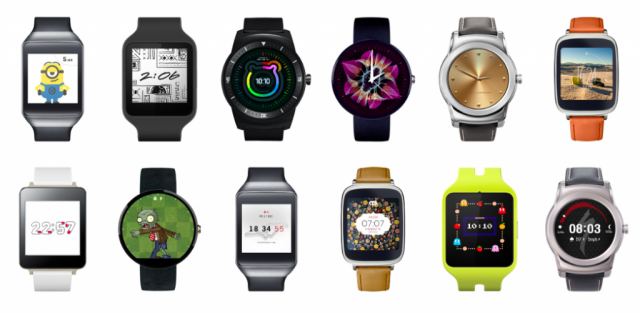
Source: Android.com
The Apple Watch is already the most popular smartwatch on the market, but it’s still early in the game. Google and all of its Android Wear partners are determined to help their smartwatch platform catch up and successfully take on Apple’s first wearable, starting with a new batch of wearables soon to be unveiled.
Shara Tibken and Roger Cheng report for CNET that a new batch of Android Wear smartwatches is on its way. Asus, Huawei, LG, and Motorola will all introduce new smartwatches at the IFA electronics trade show in Berlin, according to sources who are familiar with the companies’ product launch plans. The devices will all be powered by Android Wear, the software the Google created to power wearable devices like smartwatches. Tibken and Cheng note that Android Wear hasn’t yet resulted in any blockbuster products, even as the IFA releases will mark the second major wave of Android Wear devices, following a “dismal showing in 2014.”
Android powers the majority of the world’s smartphones, and Google and its partners are likely hoping for a similar success with the emerging market for smartwatches and other wearables. The objective seems to be for Android Wear devices to offer enough features and unique designs to pull shoppers away from the Apple Watch, which became the world’s most popular smartwatch within a few months of hitting the market earlier this year. The Apple Watch raised the bar for smartwatches across the board, and Android Wear watches have a lot of ground to make up.
Early wearables, like Samsung’s Galaxy Gear, used Android, but the initial version of the software, which wasn’t specifically tailored to wearables, caused the devices to run slowly and the batteries to drain quickly. Samsung switched to its own operating system, Tizen, for its own smartwatches. Android Wear, a version of Android modified specifically for smartwatches and other wearable devices, then launched early in 2014. Google, in partnership with Samsung, LG, and Motorola, unveiled the first Android Wear devices at Google’s developer conference in June 2014. Shortly afterward, other companies, including Sony and Asus, introduced their own smartwatches. But as Tibken and Cheng note, smartwatch manufacturers shipped only 720,000 Android Wear devices in 2014 out of a total of 4.6 million smartwatches.
Motorola is expected to follow up on its round-faced, premium-built Moto 360 with a new smartwatch at IFA. LG is expected to release a smartwatch that’s similar to its LG Watch Urbane LTE, which ran on software called WebOS; the new version will run on Android Wear. Fewer details are known about what Huawei will launch, as the company debuted its first smartwatch at the Mobile World Congress trade show in Barcelona earlier this year. Asus is expected to offer more details on the ZenWatch 2, which debuted at the Computex trade show in Taiwan. Samsung is expected to release the Gear S2, but the device will run Tizen, not Android Wear.
But not everyone is excited about the new watches coming at IFA, or about their ability to make Android Wear ubiquitous. Take Stephen Hall, who writes for 9to5Google that not only will these watches be expensive, but “Android Wear simply isn’t all that smart yet,” and none of the new smartwatches are likely to bring substantial upgrades that would be worth the investment for someone who already owns an Android Wear watch. But his concerns also cut to the core of why smartwatches aren’t yet popular among a general consumer population: they simply aren’t yet useful enough.
“Truthfully, until I have access to a smartwatch that does way more… with way longer battery life (I’m talking ignore the thing for weeks), and with a physical design that’s comfortable and sleek enough that I can sleep with it on, I’m probably not going to be a daily user of a smartwatch,” Hall writes. Android Wear is taking small steps forward, such as with a recent update that brings interactive watch faces to the platform. Hall think that’s something that Android Wear “desperately” needs to compete with features like the Apple Watch’s Digital Touch.
For Hall and for many others like him, the current crop of smartwatches are disappointing because they just aren’t as capable as we thought they’d be. (In most cases, that goes for the Apple Watch as well as the ever-widening array of Android Wear smartwatches on the market.) While any one Android Wear watch may not be able to compete with the brand recognition, premium cachet, and overall polish of the Apple Watch’s hardware and software, ultimately the platform as a whole is pushing wearable technology forward.
So it’s not out of the question that for some, even many, users, an Android Wear watch may end up being a better choice than Apple’s wearable — either once the new collection of smartwatches lands at IFA or a little farther into the future evolution of Android Wear’s software and hardware.
More from Gear & Style Cheat Sheet:
- The Big Problem With Smartwatches: Their Batteries
- 5 Cool Smartwatches You Haven’t Heard of Yet
- Would You Trade in Your iPhone for a New Samsung Phone?
Want more great content like this? Sign up here to receive the best of Cheat Sheet delivered daily. No spam; just tailored content straight to your inbox.
Read the original article from The Cheat Sheet